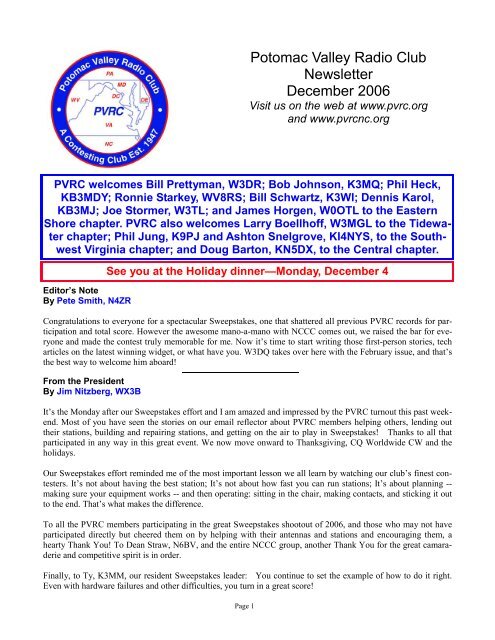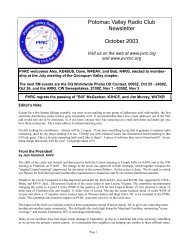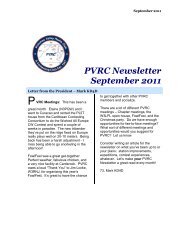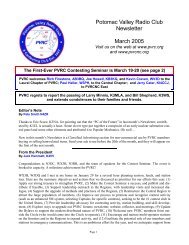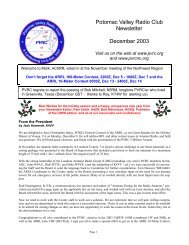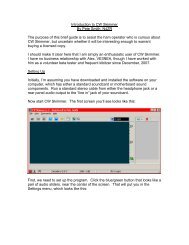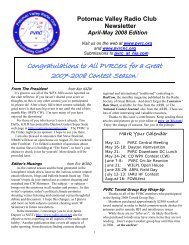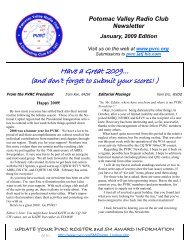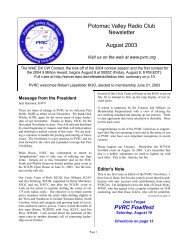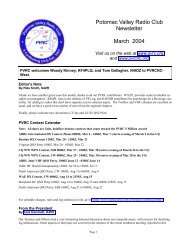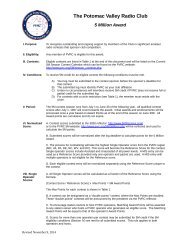Create successful ePaper yourself
Turn your PDF publications into a flip-book with our unique Google optimized e-Paper software.
<strong>Potomac</strong> <strong>Valley</strong> <strong>Radio</strong> <strong>Club</strong><br />
Newsletter<br />
<strong>Dec</strong>ember <strong>2006</strong><br />
Visit us on the web at www.pvrc.org<br />
and www.pvrcnc.org<br />
PVRC welcomes Bill Prettyman, W3DR; Bob Johnson, K3MQ; Phil Heck,<br />
KB3MDY; Ronnie Starkey, WV8RS; Bill Schwartz, K3WI; Dennis Karol,<br />
KB3MJ; Joe Stormer, W3TL; and James Horgen, W0OTL to the Eastern<br />
Shore chapter. PVRC also welcomes Larry Boellhoff, W3MGL to the Tidewater<br />
chapter; Phil Jung, K9PJ and Ashton Snelgrove, KI4NYS, to the Southwest<br />
Virginia chapter; and Doug Barton, KN5DX, to the Central chapter.<br />
Editor’s Note<br />
By Pete Smith, N4ZR<br />
Congratulations to everyone for a spectacular Sweepstakes, one that shattered all previous PVRC records for participation<br />
and total score. However the awesome mano-a-mano with NCCC comes out, we raised the bar for everyone<br />
and made the contest truly memorable for me. Now it’s time to start writing those first-person stories, tech<br />
articles on the latest winning widget, or what have you. W3DQ takes over here with the February issue, and that’s<br />
the best way to welcome him aboard!<br />
From the President<br />
By Jim Nitzberg, WX3B<br />
See you at the Holiday dinner—Monday, <strong>Dec</strong>ember 4<br />
It’s the Monday after our Sweepstakes effort and I am amazed and impressed by the PVRC turnout this past weekend.<br />
Most of you have seen the stories on our email reflector about PVRC members helping others, lending out<br />
their stations, building and repairing stations, and getting on the air to play in Sweepstakes! Thanks to all that<br />
participated in any way in this great event. We now move onward to Thanksgiving, CQ Worldwide CW and the<br />
holidays.<br />
Our Sweepstakes effort reminded me of the most important lesson we all learn by watching our club’s finest contesters.<br />
It’s not about having the best station; It’s not about how fast you can run stations; It’s about planning --<br />
making sure your equipment works -- and then operating: sitting in the chair, making contacts, and sticking it out<br />
to the end. That’s what makes the difference.<br />
To all the PVRC members participating in the great Sweepstakes shootout of <strong>2006</strong>, and those who may not have<br />
participated directly but cheered them on by helping with their antennas and stations and encouraging them, a<br />
hearty Thank You! To Dean Straw, N6BV, and the entire NCCC group, another Thank You for the great camaraderie<br />
and competitive spirit is in order.<br />
Finally, to Ty, K3MM, our resident Sweepstakes leader: You continue to set the example of how to do it right.<br />
Even with hardware failures and other difficulties, you turn in a great score!<br />
Page 1
PVRC Nominations for Officers and Trustees Continue<br />
I am pleased to continue the current nominations for PVRC Officers and Trustees. The PVRC holds elections each<br />
year for these positions, and I encourage the chapter leaders and membership to ask anyone they feel is qualified<br />
and might enjoy a leadership position a chance to run for office. Here is the current slate:<br />
1. President: Jim Nitzberg, WX3B<br />
2. Vice President: Ken Claerbout, K4ZW<br />
3. Vice President: Mark Bailey, KD4D<br />
4. Treasurer: Dave Baugher, WR3L<br />
5. Secretary: Anthony Brooks, WM3T<br />
Board of Trustees:<br />
K3MM, KE3Q, N3OC, N4ZR, W4MYA, W4ZYT, N4AF, ND3A, W3PP, K2AV<br />
The floor will remain open for additional nominations until the <strong>Dec</strong>ember 4 th Holiday Dinner.<br />
A Holiday Reminder: please mark your calendar for the <strong>2006</strong> PVRC Holiday Dinner, which will be held on<br />
Monday, <strong>Dec</strong>ember 4 th at P.J. Skidoos in Fairfax, VA.<br />
85 PVRC members and guests attended last year’s event. 69 have already registered, and I anticipate more as the<br />
date gets closer. As I will not be able to attend, Ken, K4ZW will be presiding over the dinner and distributing the<br />
awards .<br />
Please take time to truly appreciate and give thanks for everything you have during this holiday season. From perspective<br />
in the PVRC, I am truly blessed to have an outstanding team of leaders, trustees, and members to work<br />
for. I look forward to 2007 – and the contesting that goes along with it!<br />
73, Jim Nitzberg WX3B<br />
PVRC Contest and Event Calendar — all dates and times are Zulu except as noted)<br />
ARRL 160-Meter Contest 2200Z, <strong>Dec</strong>ember 1 to 1600Z, <strong>Dec</strong>ember 3<br />
PVRC Holiday Dinner, P.J. Skiddoos, Fairfax VA, <strong>Dec</strong>ember 4<br />
ARRL 10-Meter Contest 0000Z, <strong>Dec</strong>ember 9 to 2400Z, <strong>Dec</strong>ember 10<br />
Stew Perry Topband Challenge 1500Z, <strong>Dec</strong> 30 to 1500Z, <strong>Dec</strong> 31<br />
The Toolbox<br />
By Don Daso, K4ZA<br />
Slings are simply wonderful tools. I discovered them years ago while wandering through an outdoor store, and<br />
have been using them (along with carabiners) in tower work ever since. I’m speaking here of web slings— aircraft<br />
cable, metal mesh, and other types of construction do exist, but the loads encountered by most hams don’t require<br />
their heavier capabilities.<br />
And, while there are a number of precautions used in the commercial world, they won’t apply to ham use. Store<br />
them in a dark, cool place (UV is damaging) and use them properly (to me, this means not letting anyone else use<br />
them), and they’ll probably last your lifetime. Here are some ideas and guidelines for safe lifting, and suggestions<br />
for tramming loads.<br />
Page 2
Safe Lifting—There are four primary factors to consider before lifting a load: the size, weight, and center of gravity<br />
(CG) of the load; the number of legs and the angle the sling makes with the horizontal line; the rated capacity<br />
of the sling; and finally, the history or care and usage of the sling<br />
The center of gravity of an object is that point at which the entire weight may be considered as concentrated. To<br />
make level lifts, the lifting hook (from a crane or wherever) must be directly above the CG. Some small variations<br />
are usually permissible, but if the lifting point is too far to one side of the center of gravity, the object will tilt.<br />
And, as the angle formed by the sling leg and the horizon decreases, the rated capacity of your sling also decreases.<br />
In other words, the smaller the angle between the sling leg and the horizontal, the greater the stress on that<br />
sling, and the smaller the load it will safely support. Hams will not normally encounter loads that even approach<br />
the limit of the typical 1-inch or 2-inch web slings. But, know what you’re working with—read the sling’s label.<br />
The values listed are for new slings; older slings should be used with additional caution. NEVER exceed a sling’s<br />
rated capacity!<br />
The most common hitches we use to lift items are the vertical hitch, or the choker hitch and basket hitch. A vertical<br />
hitch is made directly from the lifting hook to the load, usually attached by means of another hook. A choker<br />
hitch means the sling passes entirely around the load with one loop passing through another on the sling’s opposite<br />
end, forming a simple noose pr “choke” hitch. The basket hitch means you pass the sling under and around the<br />
load, with both eyes or ends going back up to the lifting point.<br />
Sling angles are indeed important. They directly impact the rated capacity of the sling. This angle is<br />
measured between horizontal and the sling leg, regardless of hitch. Whenever pull is exerted at an angle on a leg,<br />
the tension on the leg is increased. For example, each sling leg in a vertical basket hitch absorbs 500-lbs of stress<br />
from a 1,000-lb load. That same load, lifted using a 60-degree basket hitch, exerts 577-lbs of tension on each sling<br />
leg. Without consulting some chart telling you what the increased load will be, follow this simple rule: If the<br />
LENGTH of the sling leg is greater than the SPAN or WIDTH, the lifting angle is okay.<br />
You’ll quickly realize that angles less than 45 degrees should be avoided. If you have trouble remembering, simply<br />
think about hoisting two buckets of water—one in each hand. It’s very hard to lift & hold them with your arms<br />
outspread, but you can pick and hold the buckets quite easily, with your hands and arms by your sides. Keep your<br />
loads as vertical as possible, that’s the idea.<br />
There are some excellent graphics explaining both the hitches and the implications of sling angle at http://www.<br />
fdlake.com/rig-slng.html, which are not reproduced here because of copyright considerations. The site also provides<br />
much more detail on rigging methods and equipment.<br />
Slings are swell tools, and they can make lifting our sometime heavy (and regardless of weight, cumbersome, 3-D<br />
antennas) Yagis and beams so much easier. Combined with some modern climbing accessories, rigging and lifting<br />
can actually be fun. (Even though it always takes far longer to set the rigging than actually raising the antennas!)<br />
Understanding slings and those climbing tools will make tramming antennas relatively easy. Whether it’s a small<br />
tribander or some monster Yagi, hauling antennas up and into place can be one of those moments of applied science<br />
that awes and amazes even the experienced rigger.<br />
What’s in your Toolbox?<br />
Briefly Noted…<br />
Fred Laun, K3ZO, passes on word that PVRCer Hugh Turnbull, W3ABC, turned 90 on November 1 and continues<br />
an active member of the Over The Hill Gang chapter.<br />
Congrats, Hugh!<br />
Page 3
Ammunition for Little Pistols<br />
By Bill Axelrod K3WA<br />
Wow! Did we PVRC Little Pistols come through or what? I heard a record number of you in the CW SS. And<br />
about 75% of the stations I worked in the SSB SS were PVRCers. Of course, my SSB SS only lasted 45 minutes.<br />
Only 45 minutes for a complete contest you ask? Here’s what not to do, Little Pistol or Big….<br />
In last month’s column I mumbled about getting part of my basement finished into a comfortable, modern ham<br />
shack. I got the job started, did the CW SS, and then had the contractor start up again. Left an extra 10 days in the<br />
work schedule for the inevitable “oh no”. So, with all that the job, was supposed to be done, minus paint and carpet<br />
by the Friday before the SSB SS. I should have known the rest. But, oh my, this quasi-little-pistol just wasn’t<br />
smart enough – again.<br />
Work got in the way first. And I didn’t get home to West By-God Virginia until mid-morning Sunday. And yes,<br />
most everything was done as promised. So, I got busy. First I had to clean the mess in my new radio shack room,<br />
including ladders, tools, and buckets of miracle dry wall goop. Swept up an inch of dry wall dust, etc. Keep in<br />
mind that this was the work I had planned for Saturday morning.<br />
Then I had to build my new desk. I had ordered a “Ham Desk” made by a young fellow in New Hampshire who<br />
builds desks specialized for ham radio. Expensive but worth every darn penny. The desk will outlast me.<br />
Desk built. Success. Now, all I had to do was drag all my gear out of the store room and set it up. Well ladies and<br />
gentlemen, I am officially ready to abandon my quasi-little-pistol status and go back to the simple life of a genuine<br />
little pistol. What happened to the idea of connecting an antenna to your rig, plugging it in, grabbing a pencil and<br />
log, and calling CQ Contest?<br />
Oh heck no, it’s not that simple when you are a real quasi-little-pistol. Rig, amplifier, computer, rotator, antenna<br />
switch, voice keyer, Micro-Keyer, paddles, controls to switch the beverages, the list goes on and on. And the unsightly,<br />
complex rats nest pile of wires and cables just keeps growing and growing and growing. But it all came<br />
together around 5:30 on Sunday. Oh well, about 4 hours and change left in the SSB SS. Why, I’ll be fresh meat!<br />
So, 75 meters and my first CQ. Two CQs and an answer, then another. My best run ever on 75M. Rate grows to<br />
about 115 an hour on the N1MM logger rate meter.<br />
But jeez, it gets cold on the mountain; so does my basement. 45 minutes after my first CQ I realize that I’m cold.<br />
So, like a dummy (and I don’t mean dummy load), I reach over to turn on the brand new baseboard heater in my<br />
brand new radio room. KABOOM! A big arc, a big bam! And the whole darn house goes dark.<br />
It not only gets cold in the mountains, it gets real dark. Not even the essence of light in my basement shack. Ever<br />
so slowly he walked, step by step, to find the stairs, get upstairs to where I know I have a flashlight. Bang! I walk<br />
into the wall of my new bathroom. Where did that come from? Zowie, I trip over a box of floor tile. Finally I bang<br />
my head on the stairs. All Right! Now I’m crawling. Up I go. Find the flashlight. What a relief.<br />
With light this time I go down stairs. Isolate the cursed baseboard heaters, turn on the master house breaker that<br />
tripped after the initial short circuit, re-start the furnace, and I have heat and power. And it’s time for the SSB SS<br />
to end. 45 minutes of SS glory.<br />
So, fellow little pistols, the moral of this story is never ever rebuild your shack in the contest season. Do it only in<br />
the summer.<br />
Good luck in the CQ DX , 160, and 10 meter ‘tests and have a wonderful holiday season.<br />
73 and CU in the ‘tests… Bill<br />
Page 4
Let's Play "Looney Bin"!<br />
By George Goldstone, W8AP<br />
Have you heard about the latest game? It's called "Looney Bin". You could call it "Multiple Insanity", "Super Stupidity",<br />
or whatever you want, but here is how it is played:<br />
All the players - and there are a great many of them - gather in a large confined area, which is also occupied by<br />
people who are NOT playing "Looney Bin". Each player arms himself with a club, the size of which is limited by<br />
regulations of the game to one kilogram (that's 2.2 lbs.). Some players use a hinged club, the effect of which is to<br />
transmit additional energy, so that their clubs are the equivalent of 2 kilograms - sometimes called "2KG peak effective<br />
power."<br />
The game has an announced starting time, at which time the players - and there are a great many of them, as we<br />
said - proceed to attract the attention of other players by hitting them over the head with their clubs. As the area<br />
where the game is played is usually crowded, a great many who are NOT players get hit over the head with one<br />
kilogram, which they do not like at all.<br />
The objective of the game is to see how many players can be hit over the head with one's one kilogram club. Each<br />
player must keep a record, called a log (not to be confused with the club, which is a small log of another type).<br />
The best players can hit other players over the head with their club while keeping their log with the other hand.<br />
Upon being hit over the head, a player announces (a) how sharp the blow was, rated on a 1 to 5 scale; and (b) the<br />
pressure of the blow, rated on a 1 to 9 scale. Thus, upon being struck, the player shouts "5-9", and proceeds to exchange<br />
blows with the player who has just bounced his club off the first player's head. Obviously, it takes a pretty<br />
hard head to play this game, but after partaking in a number of such contests, one's head becomes almost impervious<br />
to the blows. Many players drop their participation in such events, of course, since they see no point to either<br />
being hit on the head, or exercising violence upon others.<br />
Some parts of the playing area are more accessible than others, and the real challenge to a player is to hit the more<br />
remotely located players. When everybody tries to do this, what is known as a "pile-up" occurs, with dozens of<br />
players being hit over the head at once, and hardly anyone ever hitting the head of the player at which he had<br />
taken aim. Such "pile-ups" are very frustrating, and many players have abandoned the game because of them. The<br />
winner of the game is the player who has swung his club most effectively, hitting more players on the head than<br />
anyone else, and in more areas of the playing space. Indeed, it is considered a great achievement to have hit people<br />
on the head in every square foot of the playing area!<br />
A ticklish situation has developed as a result of so many games of "Looney Bin" being played in the playing area.<br />
Indeed, some group or other is sponsoring a game almost every weekend. The people who don't like to play<br />
"Looney Bin" actually outnumber by far those who are avid "Loonie's." But, when the non-players object to filling<br />
up the large confined area, of which we spoke, with club wielding "loonies", the objectors are called - of all<br />
things - "soreheads". If their heads are sore, it is pretty obvious what made them so.<br />
The game is played rougher in some parts of he country than in others. Cheating consists primarily of using a<br />
heavier club than the 1 kilogram rules allow. In California, it is said, clubs weighing several kilograms -as much<br />
as 18 kilograms having been reported - are sometimes used, and the hit other players' heads very, very hard. They<br />
hit non-players just as hard, and some non-players would like to abolish "Looney Bin" once and for all. How<br />
about you?<br />
[Editor’s note—I remember George from my teen-age ham days in Michigan in the 1950s, and believe he was a<br />
contester himself. According to QRZ, he is 89 years old, still living in Bloomfield Hills, and still active in the<br />
Southeast Michigan DX Association. Gee, and I thought he was really old in those days!<br />
The above was originally printed in the Auto-Call in January 1971 and reprinted in NCJ for January/February,<br />
1984. Thanks to Rich, NN3W, for finding and sharing it with us.]<br />
Page 5
My Most Memorable QSO<br />
By Fred Matos, W3ICM & YI3DX<br />
We all have memorable QSO’s in our amateur radio experiences that we recall with great pleasure. Most of us can<br />
recall our very first QSO, and I am sure that we all have many other unique QSO’s in our personal memory bank.<br />
This is one of my most memorable QSO’s that I would like to share with you.<br />
I was working on the 5-Band DXCC award back in the early 1980’s, and I needed a few more countries on 80 meters<br />
as an insurance back-up to put me over the top to assure that I was complete on 80. It was winter time at my<br />
QTH in Annapolis, Maryland, and it was early in the morning, around 1:30 or 2:00 AM or so, local time. I was<br />
slowly tuning through the 80-meter SSB DX window one last time before going to bed. I heard a QSO in progress<br />
between a GU and a ZL, with both stations coming in very strong on my 80-meter dipole that sloped pointing towards<br />
Europe. I needed the GU, having ZL already confirmed.<br />
I listened for a short time, and from the conversation, I could tell that they were nearly finished. I thought that I<br />
just cannot let this one slip away, so I broke into the QSO. The GU quickly came back to me, and he gave me a<br />
great report. He also said that the ZL heard me. I don’t know why he said that, because the ZL was very strong<br />
and I could hear him very clearly. I then worked the ZL, and he also gave me an excellent report. (I was running<br />
a KW with a Drake L-7 amplifier.) I have QSL’s from both.<br />
This was one of those cases of work them first, and then figure it out later how you did it. I can understand the<br />
nearly all-darkness propagation path between me and the GU because it was around daybreak in Guernsey, or<br />
maybe an hour or so later. But my path into New Zealand must have been via some type of skewed path or a grey<br />
line. Even more mysterious to me is the propagation path between the GU and the ZL. Is that great line?<br />
I discussed this QSO last summer at the fowl-fest with W3ZZ, Gene, and he theorized that I worked the ZL via<br />
grey line, but the GU-ZL path was still a mystery to the both of us. I invite opinions on the propagation paths that<br />
enabled the three of us to QSO each other.<br />
NCCC/PVRC Presidents Exchange Post-Sweepstakes Kudos [from the PVRC reflector]<br />
Hi Dean;<br />
We did our best - and I have to say I heard a lot, way too many NCCC folks on this weekend, and you were all<br />
about 40dB/9, even loud on 75m!<br />
This was the best club competition I've been involved with to date, and you guys (NCCC) played a first rate game<br />
and I concede that you out-did us, by miles, with those spots. Everyone at our club truly appreciated them, however<br />
I know we were lean at returning the favor. It's amazing how many NCCCers were spotting PVRCers repeatedly.<br />
I want to reiterate how NCCC took a game, a GREAT game, and made it much better for everyone. Please pass<br />
my best wishes to everyone in your club for a safe holiday season, and thank them for a job well done. One of our<br />
clubs is going to be "happier" than the other with the results, however I think we all did well this past weekend.<br />
On a personal note - thanks for saving the day for me with HFTA integration and VOACAP. Your papers, and<br />
your answers got me right where I needed to be. N6BV is on the bibliography page of a presentation I'm giving<br />
this Tuesday on using VOAAREA with HFTA antenna output to measure coverage reliability.<br />
73 - it's time for a DX contest!<br />
Jim WX3B<br />
Jim:<br />
Thank you for your kind and very gracious comments. You and PVRC are tough competitors, with a strong sense<br />
of integrity. Indeed, we at NCCC have been greatly energized by the competition from PVRC. And we know that<br />
PVRC has been energized greatly also -- perhaps too much, as seen from a purely NCCC perspective! We've all<br />
Page 6
een commenting among ourselves how many MDC and VA and NC stations were on this weekend. And we did<br />
note that PVRC was spotting stuff all weekend too. Thanks for returning the favor.<br />
Yes, we believe strongly that such strong club competitions makes it better for everyone in the contest game.<br />
Scores were certainly higher than I recall for the last solar minimum.<br />
May you and the members of PVRC have a great Thanksgiving.<br />
K,D & 73,<br />
Dean, N6BV<br />
My Life Abroad in Ham <strong>Radio</strong>—Continued<br />
By Fred Laun, K3ZO<br />
[continued from last month—Fred in Thailand]<br />
Based on my experience with earlier bosses, the minute I got back to my office I went in to see Jim and began to<br />
download for him the mass of intelligence I had stored in my cranium during my lunch with Kitti. Jim held up his<br />
hand and said: "I don't want to hear it. People will get the idea you're working for somebody else. The next time<br />
you have lunch with Kitti and he starts to bring stuff like this up, change the subject.” Excellent advice and I have<br />
admired Jim ever since for saying it, but that's not the way the vast majority of my colleagues felt. It didn't take<br />
long for me to learn that, regardless of the turf wars that our home agencies might be engaging in back in Washington,<br />
overseas we were all members of one Embassy Country Team led by the Ambassador and as such we each<br />
contributed our respective special skills to the mission of the Embassy which was spelled out in documents drawn<br />
up at the Embassy and ratified by Washington each year.<br />
Nevertheless after Jim's warning I became more circumspect in how I handled such useful information to which I<br />
generally came quite by accident. It was all I could do, for example, when, during a party at my house in Nicaragua<br />
for a bunch of the local hams, where generous servings of cocktails had the standard effect of loosening<br />
tongues, one fellow began to talk about how he maintained all the repeaters for the Sandinista leaders so that they<br />
could communicate with each other by radio no matter where they happened to be at the time, and the frequencies<br />
they used were ---. It was all I could do to keep from grabbing a piece of paper and writing them down, but instead<br />
I stopped him and changed the subject to that of his family. In short order I learned that his 14-year-old son was a<br />
fanatic about airplanes. Not long after that the boy's room was decorated floor to ceiling with posters of all the latest<br />
USAF aircraft and the Air Force Attaché had the list of frequencies that I had so carefully refrained from accepting.<br />
As I explained in my earlier story about Santo Domingo, the special knowledge about radio that I had acquired,<br />
often without realizing it, was at times useful to our mission, and I felt I had to act on it even though USIA back in<br />
Washington might not have wanted me to do that for exactly the reasons my former boss Jim had stated. I had to<br />
act on it because I knew it would be useful to the U.S. mission and that I was the only one on staff who had the<br />
capability to find out what we needed to know.<br />
To use Nicaragua as an example again, I had applied for a ham license there as I had at all of my other overseas<br />
postings. The Sandinista Government never said "no" but they never said "yes" either. I had taken a Drake line<br />
with me to Managua in the belief that I could get a license due to the fact that a reciprocal operating agreement<br />
existed between our two countries. While awaiting the license which never came I strung up a 40 meter dipole in<br />
the back yard and hooked the R4C receiver up to it. Just before leaving for Nicaragua I had installed my 80 meter<br />
beam here and rented my place to Dave Pascoe, KM3T and I wanted to know how the beam sounded at the other<br />
end, so by pre-arrangement Dave would point the beam south while occupying the DX window on 75 and call CQ<br />
DX and work whatever KP4's, YV's etc that would answer while I would be listening. One night while listening<br />
for Dave I ran across a loud carrier and, turning off the BFO I found it was an AM broadcast of the El Salvador<br />
rebel radio, "broadcasting from liberated territory in El Salvador". Strangely enough the station had rapid QSB<br />
which almost sounded like aurora flutter, but in fact you seldom hear aurora flutter at that latitude, especially on<br />
Page 7
75 meters.<br />
So I began to put two and two together the way nobody else in the Embassy would have been able to. The QSB<br />
was caused by interference between the station's skywave and ground wave; this meant that the transmitter in fact<br />
had to be located pretty close to Managua. This was not really surprising because the Sandinistas were known to<br />
be sympathetic to the rebels in El Salvador. I reported the matter to the Ambassador and was later asked by someone<br />
else in the Embassy to try to track the exact location of the transmitter down.<br />
It so happened that at the same time VOA was trying to find a way to put a strong medium wave signal into downtown<br />
Managua. An earlier attempt to do so by means of a 50 KW transmitter in Costa Rica had been a miserable<br />
failure because the design of the transmitting antenna had been your standard medium wave vertical array design,<br />
which depends on ground wave to cover the target area. The low angle of whatever sky wave the array emitted<br />
caused the signal to skip right over Managua and instead cause QRM to a long-time occupant of the same frequency<br />
in Veracruz, Mexico, and that station was complaining bitterly to Washington, which was already upset by<br />
the fact that the Costa Rica station wasn't doing the job expected of it in Nicaragua.<br />
Our Ambassador in Costa Rica at the time, Prof. Lew Tambs, had been my Ambassador in Colombia for most of<br />
my time there and we had hit it off very well. Lew was a political appointee and I found in my career that all in all<br />
it was easier to be a press spokesman for a political appointee than for a career officer of the State Department<br />
since most career State Department officers were scared to death to talk to the press for fear that they might inadvertently<br />
say something which would cause them problems with the bosses in Washington and thereby have a<br />
negative effect on their careers. Since Lew knew I was a ham he asked my personal opinion of why the installation<br />
in Costa Rica wasn't living up to expectations and I told him that it was because whereby the designers had<br />
maximized ground wave in their design, what was needed was an installation which maximized sky wave. He<br />
pulled some strings and not long afterward I was in Washington saying the same things to VOA engineers. Many<br />
of them had already come to the same conclusion and so a new site was acquired, in Belize, and VOA proceeded<br />
to erect a multi-element horizontal wire array fixed on Managua. When they were ready to start testing the new<br />
station they sent me a very nice field strength meter (probably the FIM-41 -- see http://www.pi-usa.com/fim2241/<br />
fim2241g.htm) and asked me to make measurements at different specified times.<br />
I happened to be in posession of this FSM when the matter of the Salvadoran rebel transmitter arose, so Somporn<br />
and I piled in our car with the FSM between us and drove around suburban Managua until the signal of the rebel<br />
transmitter began to get really strong. With the FSM you could switch in several levels of attenuation so that when<br />
it began to overload you would switch in more attenuation and keep going. Finally when I got to the point where a<br />
seated sentry with a rifle across his lap blocked the way I decided to turn around and head back home. If the Embassy<br />
wanted to pinpoint the place any further they would have to assign the job to somebody who was in that line<br />
of work. It so happened that a ham friend of mine in Managua lived not far from the location of that clandestine<br />
transmitter, and when I mentioned it to him he asked me why I hadn't asked him before. It turned out he knew<br />
very well where the station was because he and his neighbors were bothered constantly by its TVI!<br />
Around the same time another U. S. Government agency had erected a powerful station in El Salvador beamed at<br />
Managua and, unlike the VOA, whose news may have been critical of the Sandinistas but only in a general way,<br />
always using polite terms when referring to particular individuals, the El Salvador station had been turned over to<br />
Nicaraguan anti-Sandinista exiles who were not shy about referring to particular Sandinista comandantes in the<br />
grossest of terms, detailing their sexual exploits and other indiscretions in which they had been alleged to engage.<br />
The comandantes were not amused and proceeded to set up a jamming station which would at least prevent the<br />
station from being heard in most of Managua, though they couldn't do much about blocking it in the rest of the<br />
country.<br />
By this time I had learned that the by using the FSM, which had very sharp nulls, at my residence, I could map the<br />
general locations of all the AM transmitters in Managua, so when I was asked to get a fix on the Sandinistas' jamming<br />
station the task proved quite easy. In fact I was able to tell the Ambassador that, each day as he went to<br />
work, if when he passed the drive-in chicken restaurant on his left, he instead would look to his right, he would<br />
see the two towers from which the jamming station's horizontal wire was suspended. This information was turned<br />
Page 8
over to the aforementioned Air Force Attaché who did a full report on the site, complete with photos, which<br />
earned him a nice commendation from Washington.<br />
The opportunity to help the government acquire useful information didn't only happen to me overseas. During one<br />
of my Washington assignments I was approached by a ham friend who at the time was with a company whose<br />
business included installing navigation equipment in private aircraft from all over the Western Hemisphere. My<br />
friend said that he was learning things that he thought the U. S. government wasn't aware of and ought to know,<br />
and as a patriotic American citizen he wanted to report. I spoke to another ham friend of mine in an appropriate<br />
government position and suggested that he have an old-line officer close to retirement debrief my friend on a regular<br />
basis. The particular request that an officer close to retirement be the contact was based on long experience<br />
which taught me that eager young careerists are not the best at handling information from useful sources because<br />
they were more likely to embellish the information in order to try to enhance their careers.<br />
My request was fulfilled to the letter and the information provided proved so useful that the ham friend in government<br />
who I had approached received a commendation as a result. Unfortunately as time went on a rival government<br />
agency learned of this useful flow of information and pulled rank to take over the debriefing of the contact.<br />
The eager young officer appointed to do the job seemed to be more interested in learning from my friend how to<br />
go into private business for himself and make lots of money than he was in the information my friend was providing,<br />
and my friend broke off the contact in disgust.<br />
All of the above by way of saying that those of us in the Foreign Service but not specifically in the business of<br />
gathering intelligence would nevertheless run across opportunities to contribute useful intelligence simply by happenstance.<br />
The wide variety of specialized knowledge and acquaintances one acquired by being an active ham<br />
contributed directly to this ability, as can be seen, both on the input and output side of the intelligence pipeline.<br />
‘Twas the Season for Contesting.…<br />
By Jose Castillo, N4BAA<br />
‘Twas the season for contesting<br />
And all through the house.<br />
N1MM running ....<br />
With both keyboard and mouse.<br />
The antennas were hung on the tower with care<br />
In hopes of a high score from QSOs everywhere.<br />
The macros where programmed and ready to go,<br />
As I watch the clock tick for the start of the show.<br />
All monitors lay out so as to properly see<br />
The points coming in as I smile with much glee.<br />
When out of the QRM I strained to make shown,<br />
A much needed contact, "YES!" a new zone!<br />
The hours did pass, some fast and some slow,<br />
Watching my score build....up up and up grow!<br />
I glance out my window to see the north star,<br />
A sign from above ...next time SO2R!<br />
Amidst the long contest, "Band Mapping" for more,<br />
CQ'n away ... I glance to the door.<br />
My wife stood in amazement and shaking her head,<br />
"Good luck dear, have fun...I'm going to bed."<br />
I gave her a smile and a smooch through the air,<br />
Page 9
And return my tired eyes to the monitor glare.<br />
Excitement at dawn as the "gray line" gets near,<br />
Faint signals on low bands that I'm straining to hear.<br />
Search and Pounce seeming best at this time of the day,<br />
As all of the big guns are blasting away!<br />
As the Low bands piddle out and its a band change to twenty,<br />
Where no matter the time, you can always find plenty!<br />
Checking for mults on the other bands as well,<br />
As they open to Europe, it surely is hell.<br />
When the sun rises high the east coast is hopin',<br />
That 10 will give way to the south, "PROPAGATION OPEN!"<br />
As the contest slows down and comes to a end,<br />
A submittal of score and a hope for a win.<br />
Months slowly pass for both me and for you,<br />
When finally the score...in QST or CQ!<br />
As I glance down the list to see how I did,<br />
Anticipation is high and I feel like a kid!<br />
Down further, down further... and FINALLY I see,<br />
MY score it is listed....for PVRC!<br />
Around the <strong>Club</strong><br />
Meeting Minutes from the Chapters<br />
PVRCNC-East November Meeting Notes—Our November meeting was reserved for a special celebration....The<br />
10th anniversary of the birth of the NC Chapter of the PVRC. During that time, the NC chapter has grown, matured,<br />
and welcomed many new contesters into the fold. Now there even exist two geographical groups within<br />
PVRCNC...East and West!<br />
Our guest of honor and founder of the chapter, Howie (N4AF), made the trip to Raleigh from his QTH out east.<br />
We had one of our strongest turnouts in recent history, enjoyed a wonderful time of remembrances, saw some excellent<br />
pictures depicting many of us a "few" years younger, and were quizzed with another challenging "Paper<br />
Contest." The 21 in attendance were: W0UCE, Jack; K4CIA, Bill; NX9T, Jeff; N4TL, Tom; W4KAZ, Keith;<br />
K4QPL, Jim; K1ZW, Larry; NT4D, Jay; K2AV, Guy; AD4L, Pete; KE4GY, Frank; N1LN, Bruce; N1YXU, Laurie;<br />
AL4T, Brad; W4MY, Marty; KC4HDI, Chris; N4AF, Howie; KA1ARB, Rob; N2NFJ, Bob; N4YDU, Nate;<br />
and N4PY, Carl.<br />
K4QPL welcomed the group and outlined the evenings agenda. W0UCE conducted the regular "Paper Contest."<br />
This month was another "Sprint" and involved answering questions about our chapter "Big Gun- aka N4AF."<br />
Howie of course won but there was a 6 entry tie for second and, surely out of an act of pity, NX9T was awarded<br />
the victory and took home the multi-role pack of black tape. Pete, AD4L presented an array of recollections from<br />
group members concerning N4AF, operating at his station, and the many who credit Howie with influencing their<br />
contesting career. Jim, K4QPL, presented a Certificate of Appreciation to Howie as a way to recognize the many<br />
contributions Howie has made to PVRC in general, and more specifically, to PVRCNC.<br />
Member Reports:<br />
N4AF: Howie remarked on how it does his heart good to see how the chapter has grown over the years. At home,<br />
he has been working on antennas and preparing for SS and CQWWCW. K1ZW: Larry worked 250 Q's during the<br />
CQWW and has been adding to his antenna farm. The most recent additions include multiple verticals. K4CIA:<br />
Bill is contemplating a QRP SSCW effort. Otherwise, most of his time has been spent DXing.<br />
Page 10
NX9T: Jeff played in the CQWW to the tune of over 700 Q's and will be on for the Sweeps.. some CW and more<br />
aggressively for SSB.KE4GY: Frank listened in some during the CQWW and reports that his station is working<br />
well these days. N1LN: Bruce is ramping up for a 24 hour effort in SSCW. He has been working on various antenna<br />
and rotator installations issues. Plans to do a "multi" with N1YSU during SSB Sweeps. N1YXU: Laurie reported<br />
that she and OM N1LN have been working on an Emergency Communications presentation for another<br />
group of which they are members. She hopes to be on the air during the SS SSB.<br />
AL4T: Brad tuned into the CQWW for an hour or so and plans to be on for SS. He has been working on a K9AY<br />
RX loop and other antennas. He reportedly "burned up" a tribe of USB ports recently! N2NFG: Bob stated that his<br />
last serious operating was during the CQP. He does plan to be on for SS and some RTTY tests. N4YDU: Nate operated<br />
during the CQWW and plans to be on in the SS. N4PY: Carl has been doing some Dxing with his Orion as<br />
well as enjoying his new QTH in the NC mountains!<br />
W4MY: Marty is pleased to announce that his tower has been completed. It is now sporting a C3 and XM240.<br />
These antennas led to a fun time during the CQWW. KC4HDI: Chris, XYL of W4MY, reported that she has been<br />
assisting Marty with his tower projects. K4QPL: Jim has been preparing for the SS and intends to go at it hard! He<br />
did miss the CQWW but has been getting his new Orion all set up and ready to go.<br />
N4TL: Tom worked around 300 Q's in the CQWW and plans to be on in both modes for SS. W4KAZ: Keith<br />
played some in the CQWW but has been busy with projects around the house (note: and putting together our great<br />
SS page on the PVRCNC webpage). W0UCE: Jack happily reported "no lightening strikes" for the month of October!<br />
He is putting up a new dipole for SS and has been enjoying his new key. NT4D:Jay indicated that his tower<br />
has been repaired and his antennas (big'ns) are back up.<br />
K2AV: Guy is also preparing for SS. He has installed N1MM, made final coaxial connections, and is putting up a<br />
new "K2AV Special" for 40m. AD4L: Pete has been busy with school, his new hobby (motorcycle racing), and<br />
helping Howie with some antenna work He plans to be on for the SS.<br />
KA1ARB: Rob is getting ready for SS by adding wire beams for 40m. He is planning on putting together a Multi-<br />
Op for SS SSB.<br />
EMAIL REPORTS: K4TMC: Henry will be operating during the SS SSB. K4CZ: Barry continues to work on his<br />
tower/antenna and reports that his station is working great. He was on for the CQWW and will be on during the<br />
Sweeps.<br />
Our annual plea for contributions for the costs associated with the web page and other smaller expenses was made.<br />
To the credit of our group, the need was met (exceeded) by the end of the meeting! We ended with a SS Rally Cry<br />
and a plan to personally contact members who haven't been around recently in order to encourage them to join in<br />
on the fun with SS.<br />
We look forward to another great gathering in <strong>Dec</strong>ember. Don't miss out...mark your calendars now for <strong>Dec</strong>ember<br />
7th and join us for dinner and a chance to fill us in on your SS (CW and SSB) and CQWW CW adventures!<br />
73, Jeff, NX9T<br />
The November Central Region PVRC Meeting was held at Topolino's Restaurant in Clinton, MD, on Monday,<br />
November 13. We had a great crowd: KC3VO, WR3Z, N3ST, KN5DX, KD4D, KE3Q, K3ZO, W4EE, WM3O,<br />
K4VV, N3RR, W3TOM, W3UL, KI3O, and K3WI<br />
PVRC Business: We are pleased to announce that three new members were voted into PVRC: Larry, W3MGL,<br />
Phil, K9PJ, and Doug, KN5DX (present!). Jack (K4VV) passed some great looking antenna pictures around the<br />
room, and Mark, KD4D led a lively discussion on the "Top 10 ways to help PVRC win the Gavel Back".<br />
Page 11
It was Bill, K3WI and Doug, KN5DX's official welcome to PVRC. A fine dinner and fellowship was enjoyed by<br />
all.<br />
73, Mark KD4D Jim, WX3B<br />
The Northwest Region met at the City Buffet in Frederick,<br />
MD on October 17. In attendance were:<br />
WF1L, N3VOP, W2YE, K2PLF, N6WHB, W3KHZ,<br />
W3EKT, K4ZA, W3CQH, K4VV, W0YR, W8LRL,<br />
K3OQ, W3ZZ, W3IDT, W3LJ, K3NCO, W8ZA,<br />
W6NRJ, WN3R and W3LL.<br />
KI4NYS, Ashton was voted into PVRC tonight.<br />
Ashton is a member of the Virginia Tech radio club.<br />
He's a new ham and has taken an interest in contesting.<br />
Ashton's first meeting was at Dayton and second one<br />
at the SWVA chapter. Bud, W3LL nominated Ashton<br />
who was then voted unanimously into PVRC. Welcome<br />
aboard Ashton! Applause!<br />
From Around the Table:<br />
See Audio File of this meeting on the PVRC website.<br />
The meeting adjourned at 7:55 PM.<br />
73, Bud W3LL, Chairman<br />
Advertise in the Newsletter —<br />
It Works!<br />
Contact Dave, WR3L<br />
(dave@wr3l.net) for details<br />
THE R. F. CONNECTION<br />
"Specialists in RF<br />
Connectors and Coax"<br />
213 North Frederick Avenue<br />
Suite 11-F<br />
Gaithersburg, MD 20877<br />
Tech Support:<br />
301-840-5477<br />
24-hour Fax:<br />
301-869-3680<br />
Order line:<br />
800-783 -2666<br />
Email: rfc@therfc.com<br />
Please visit us at:<br />
Http://www.therfc.com<br />
Our catalog includes:<br />
Tower Works<br />
Specializing in Rohn guyed towers<br />
Don Daso<br />
515 Withershinn Drive<br />
Charlotte, NC 28262<br />
704-594-9853 704-408-7948 (cell)<br />
E-mail: k4za@juno.com<br />
Call or e-mail for rates and availability<br />
UHF Series, N Series, BNC Series,<br />
Adapters, F Series, DIN<br />
Plugs, Portable <strong>Radio</strong> Power,<br />
DIN Plugs, Hardline Connectors,<br />
Audio Connectors, Microphone<br />
Connectors, FME Series, SMA<br />
Series, Reverse Thread SMA<br />
Connectors, MCX Series,<br />
MMCX Series, Adapter Kits, Reverse<br />
Polarity (TNC, N, SMA),<br />
39 coax types and 5 balanced<br />
lines<br />
Page 12
Page 13


